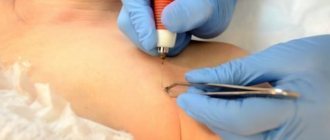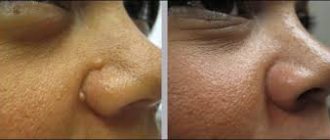A lot of information is given about moles on the human body. Some argue that they are associated with a person’s physiological characteristics, and astrologers using moles can predict the future, determine a person’s character, etc.
INTERESTING: Moles are congenital or acquired over time changes on the skin, neoplasms or benign tumors. Flat moles hardly cause any harm to the owner, but convex moles constantly cling to something and get damaged. They also differ in color. A normal mole is a light brown or tan colored formation. For any deviations or changes (colors, increase in size, appearance of bulges), be sure to visit an oncologist.
The question of whether it is harmful to remove moles is difficult to answer. After removal, complications may arise as a result of infection. If a mole is not removed, the risk of developing a malignant tumor increases. The cause may be long exposure to the sun, since ultraviolet rays have a detrimental effect on moles, as well as injury, hormonal imbalance, chronic diseases, even ordinary mechanical damage.
Whether it is worth removing moles is up to each person to decide for himself; this is a purely individual matter. Many people live with moles all their lives, and some believe that they spoil their appearance. Nowadays, in addition to self-medication, there is also surgical intervention. There is no need to panic, as science has made great progress and every year new methods are being invented to get rid of moles.
What's happened
Electrocoagulation is a method of removing papillomas using electric current. It is carried out using a special apparatus.
A loop attached to an electrode is placed on the neoplasia. Under the influence of current, the loop heats up and cuts out the base of the growth.
The blood vessels that feed the neoplasm are sealed, due to which the blood supply is stopped. This prevents the development of infection and prevents bleeding after the procedure.
On this topic
- Skin covering
Tumor on the face
- Natalya Gennadievna Butsyk
- December 10, 2020
The effect is only on pathological tissue. Healthy cells located nearby or in depth are not affected. This makes the procedure safe.
Its effectiveness depends on the degree of professionalism of the doctor. There are still certain risks. It is very important to choose the correct size of the loop so as not to damage healthy tissue. You also need to take into account the features of the clinical picture, the number of papillomas, their size, the form of the disease, etc.
Cost of the procedure
| Papilloma diameter | Cost of removal, rubles |
| from 1 to 2 mm | 300 |
| from 2 to 5 mm | 600 |
Some centers offer a discount on the procedure if a large number of elements are removed at once. Local anesthesia and general anesthesia are paid separately.
Find out what contraindications the procedure for removing papillomas on the face with a laser has.
What are the consequences of removing moles using electrocoagulation? More details at the link.
What is facial ozone therapy, what consequences, complications and side effects does it have? All about this in the link.
Indications
Removal of papillomas with electric current is carried out under the following circumstances:
- increase in the size of the tumor;
- change in color of papilloma;
- the emergence of a large number of new neoplasias;
- location of the growth in an area where there is a high risk of damage;
- the appearance of pain in the affected area.
Any of these features requires contacting a specialist. They indicate the likelihood of cells degenerating into a cancerous tumor.
But even without the listed symptoms, this procedure can be prescribed. This is done when papillomas are found on visible areas of the body, which negatively affects a person’s appearance.
Risk factors
Today, an increasing number of people suffer from a disease such as melanoma.
Photo: signs of tumor degeneration
Often a person does not notice how a harmless mole begins to develop into a global problem that is quite difficult to cure.
Risk factors for a mole turning into melanoma include the following:
- genetic predisposition;
- mole injury;
- disorders in the endocrine system;
- changes at hormonal levels;
- abuse of sunbathing.
Contraindications
In some cases, removal of papillomatous formations by electrocoagulation is prohibited. This is associated with the risk of complications that may arise due to the individual characteristics of the body.
Contraindications include:
- presence of a pacemaker;
- acute viral
- clotting disorder ;
- exacerbation of herpes;
- chronic diseases in the acute stage;
- intolerance to exposure to electric current;
- allergic reactions to medications;
- oncological diseases;
- pregnancy;
- natural feeding.
Some of the listed contraindications are not strict. This applies to viral diseases or exacerbations of chronic diseases. After neutralizing the problematic phenomenon, papillomas can be removed using an electrocoagulator. In other cases, the use of this method is strictly prohibited.
Progress
The principles of the procedure involve the effect of electric current on damaged tissue. They warm up, after which the papilloma is destroyed.
The work is performed by a small device called an electrocoagulator. It emits high frequency current. The effect is carried out through a small loop, which is placed over the skin growth.
Thanks to the presence of different attachments, papillomas can be removed with an electrocoagulator in any area, even difficult to access.
On this topic
- Skin covering
Treatment methods for atheroma without surgery
- Natalya Gennadievna Butsyk
- December 9, 2020
The destruction of the tumor does not occur immediately. The cells die within a few weeks. At this time, the patient needs medical supervision. Therefore, after the procedure, the patient should visit a medical facility once or twice a week.
Electroexcision is carried out using local anesthetics. Before starting work, the skin is treated with an antiseptic. The duration of the manipulation is approximately 15 minutes. Since the electrocoagulator is small in size, the procedure can be performed at home.
During electrocoagulation, thermal damage occurs to tissues, which then die. High temperatures seal the blood vessels, preventing bleeding.
After manipulation, a dense crust forms on the skin. After a few weeks, it sloughs off, and a new layer of skin forms in this place. If there are disturbances in the regeneration process, laser resurfacing is performed.
Removal of papillomas using electrocoagulation does not guarantee complete recovery. These formations are formed under the influence of the human papillomavirus, which remains in the body for life. Therefore, under favorable circumstances, new growths may form.
After care
After electrocoagulation, a small wound remains on the skin. Over time it will heal. In order for the regeneration process to go faster, proper skin care after the procedure is necessary.
After a few days, the wound heals and a dry crust forms in its place. There is no need to remove it - it will go away on its own in about 2 weeks.
If the crust is damaged, skin restoration will be disrupted, and a pigment spot will form in this area. In particularly severe cases, bleeding may develop.
On this topic
- Skin covering
Why does the wen itch?
- Olga Vladimirovna Khazova
- December 5, 2020
A healing wound should be treated with an antiseptic every day. This will prevent infection. This treatment must be carried out until the crust peels off.
During the recovery period, you should not use cosmetics or aggressive detergents. Exposure to the sun should be limited and you should not visit the solarium.
After the skin has recovered, the area should be protected from adverse effects with moisturizers or sunscreens. Frequent use of decorative cosmetics is undesirable. To boost immunity, you should take vitamin complexes.
Ways to remove moles
When removing moles, it is important to remember that you need to remove only those that are indicated for removal (that is, those that change color, appearance, shape, etc.).
Do not try to lubricate them with ointments, creams, celandine and other “medicines” or tie them with silk thread in the hope that they will “fall off”. Remember that any careless handling of a mole can lead to malignant formation.
The method of removing a mole is determined by the doctor, depending on its condition, the patient’s tests and other factors.
Before removing a mole, consult with an oncologist and get the appropriate tests: a mole can be malignant, so it is better to have it removed in an oncology center, rather than in a regular medical center, which are increasingly offering a similar service. A consultation with an oncologist is required if: the mole has darkened, its size has changed, it has become inflamed, crusted over, etc. In this case, it is necessary to undergo a complete histological examination.
Important: only after the nature of the mole has been clarified can it be removed. Conventionally, the method of removal can be divided into: surgical and non-surgical.
And if everything is clear with the surgical method of removing moles - they are removed using a scalpel, then there are many more non-surgical methods of removal: laser, liquid nitrogen, electrocoagulator. Below we will talk about the advantages and disadvantages of each method.
Are there any consequences or complications?
If the manipulation is performed correctly, no complications arise. They are possible due to technology violations, the presence of contraindications or improper care after electrocoagulation.
In these cases, bleeding and allergic reactions may occur. Allergies are provoked by medications used during electrocoagulation or after it - to treat the wound surface. Because of this, the regeneration period may be delayed.
Bleeding occurs when large vessels are damaged during the procedure. Therefore, it is very important that papilloma removal is carried out by an experienced specialist.
On this topic
- Skin covering
What does a wen look like on the body?
- Olga Vladimirovna Khazova
- December 5, 2020
If an infection has been introduced into the wound, an inflammatory process may begin with the formation of pus. The same consequences can occur if the crust is forcibly removed. It is also possible for pigment spots or scars to form.
Failure to comply with precautions may cause re-formation of papilloma or the appearance of atypical cells in this area. Under favorable circumstances, they can degenerate into a malignant tumor.
This occurs due to injury, infection, sun and chemical burns and under the influence of harmful substances. Therefore, it is necessary to protect the skin from dangerous influences.
Advantages and disadvantages
This method of removing tumors is considered old. Its use is still due to its advantages.
These include the following:
- The removal process does not take much time. The procedure takes about 10 minutes. If you need to eliminate a small papilloma, it takes less than 5 minutes.
- The method has no age restrictions. It can be used for adults and children. Electrocoagulation is also suitable for older people.
- The procedure is used for any type . Some caution is required for sensitive skin. This is due to possible pain sensations that may be aggravated in them. Therefore, people with it need stronger painkillers.
- There are no restrictions regarding the size of the tumor. Using electric current you can remove small and large papillomas.
- Minimal risk of complications. If you follow the technique and medical recommendations for care, electrocoagulation is a safe procedure.
- During the manipulation, the pathological tissue is not destroyed, which makes it possible to subsequently study it for the presence of malignant cells.
Some patients and doctors speak negatively about this procedure. This is explained by the presence of shortcomings.
Soreness
For sensitive skin, electrocoagulation may cause discomfort. Because of this, strong analgesics must be used.
Appearance of scars
They can form if the procedure is carried out incorrectly or care recommendations are not followed. This also happens when the wrong treatment method is chosen.
How to remove papillomas using electrocoagulation
Before proceeding with the elimination of papillomas, the dermatologist must be sure that there are no restrictions on treating the patient with this technique. The procedure itself does not require special preparation and does not take much time; 5-10 minutes are enough to remove a small growth.
The surgeon applies an antiseptic to the area of skin affected by the virus and injects the coagulation area with local anesthetics. The electric knife touches the tissues surrounding the papilloma and burns out the tumor layer by layer, after which the wound is treated with antiseptic. The very next day, a protective crust appears at the burn site, under which a new healthy epithelium matures. The duration of the recovery period and the likelihood of developing unwanted complications depend on how correctly the skin is treated after removal of papillomas with electrocoagulation.










